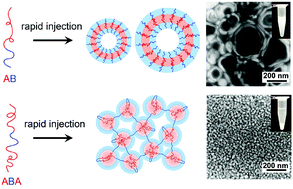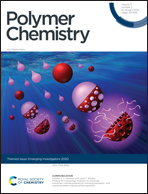Influence of block sequence on the colloidal self-assembly of poly(norbornene)-block-poly(ethylene oxide) amphiphilic block polymers using rapid injection processing†
Abstract
An accessible and robust method for preparing colloidal nanostructures from amphiphilic block copolymers is of significant interest due to their wide-spread usage in biomedical applications. Traditional colloidal block copolymer self-assembly methods such as slow water addition, film rehydration, and electroformation are often costly and time-consuming due to the lengthy preparation procedures. Rapid injection, where the initial amphiphilic block copolymer is dissolved in a good solvent, and rapidly injected into a selective solvent, offers a convenient, effective, and versatile approach for preparing colloidal nanostructures. A better understanding of the self-assembly mechanism and guiding principles will allow broad implementation of rapid injection mediated block copolymer self-assembly for a variety of applications. Another important prerequisite and driving force in nanostructured polymer materials is to develop innovative polymerization methods capable of generating block copolymers with different polymer chemistries as well as molecular architectures. In the work presented here, poly(norbornene)-block-poly(ethylene oxide) (NO) diblock and NON triblock copolymers were synthesized by using two controlled polymerization methods: ring opening metathesis polymerization (ROMP) and living anionic polymerization (LAP). The self-assembly behaviors of AB diblock and ABA triblock copolymers were studied using rapid injection. A variety of colloidal nanostructures including spherical micelles, worm-like micelles, vesicles, and microgels were readily prepared by tuning polymer concentration and architecture. Due to the robustness of the self-assembly process, hydrophobic gold nanoparticles (AuNP) can be co-assembled with the block copolymers as an accessible strategy to install functionality into nanostructures. Combining innovative polymerization and processing methods, various colloidal structures with desired functionality can be readily prepared in a controlled manner. The findings presented here are beneficial for developing a selection of block copolymer-based colloidal systems with applications in various technologically important areas, such as drug delivery, nanomedicine, and diagnostics.

- This article is part of the themed collection: Polymer Chemistry Emerging Investigators


 Please wait while we load your content...
Please wait while we load your content...
